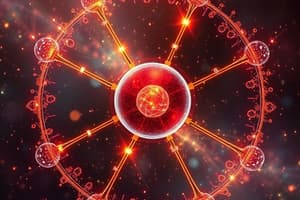Podcast
Questions and Answers
Who discovered neutrons, neutral particles found in the nucleus of an atom?
Who discovered neutrons, neutral particles found in the nucleus of an atom?
- James Chadwick (correct)
- J.J. Thomson
- Goldstein
- Dalton
What is the charge of protons and neutrons respectively?
What is the charge of protons and neutrons respectively?
- 0 and +1
- +1 and 0 (correct)
- +1 and -1
- -1 and +1
Which experiment led to the discovery of electrons and their characteristics?
Which experiment led to the discovery of electrons and their characteristics?
- J.J. Thomson's cathode ray experiment (correct)
- Goldstein's anode rays experiment
- James Chadwick's neutron discovery
- Dalton's atomic theory
What did Goldstein's experiment observe that led to the identification of protons?
What did Goldstein's experiment observe that led to the identification of protons?
Who proposed the atomic theory that atoms are indivisible and indestructible particles?
Who proposed the atomic theory that atoms are indivisible and indestructible particles?
Which particle has a mass of approximately 9 * 10^-31 kg and a negative charge?
Which particle has a mass of approximately 9 * 10^-31 kg and a negative charge?
What is the relative charge on a proton compared to an electron?
What is the relative charge on a proton compared to an electron?
What is the mass of a proton in kilograms?
What is the mass of a proton in kilograms?
Which particle is found in the nucleus of an atom and has no charge?
Which particle is found in the nucleus of an atom and has no charge?
Who discovered the neutrons in an atom?
Who discovered the neutrons in an atom?
What charge do protons carry?
What charge do protons carry?
Which experiment observed streams of positively charged particles similar to cathode rays?
Which experiment observed streams of positively charged particles similar to cathode rays?
What did J.J. Thomson discover in his cathode ray experiment?
What did J.J. Thomson discover in his cathode ray experiment?
What is the charge on an electron relative to a proton?
What is the charge on an electron relative to a proton?
Study Notes
- Dalton's atomic theory revolutionized the understanding of matter, proposing that atoms are indivisible and indestructible particles.
- Neutrons, discovered by James Chadwick in 1932, are neutral particles found in the nucleus of an atom, with no charge.
- Electrons, protons, and neutrons make up the structure of an atom.
- J.J. Thomson's cathode ray experiment in 1897 discovered electrons, negatively charged particles with a mass of 9 * 10^-31 kg.
- Protons, positively charged particles in the nucleus, have a mass of 1.6 * 10^-27 kg and a charge of +1.
- Neutrons, electrically neutral particles in the nucleus, have a mass of 1.6 * 10^-27 kg and no charge.
- Goldstein's experiment observed streams of positively charged particles (anode rays) similar to Thomson's cathode rays experiment.
- Goldstein's discovery led to the identification of heavy positive particles (anode rays) ultimately as protons.
- The relative charge on an electron is -1, while the relative charge on a proton is +1, simplifying calculations.
- Understanding the properties and characteristics of electrons, protons, and neutrons is fundamental to comprehending atomic structure.
Studying That Suits You
Use AI to generate personalized quizzes and flashcards to suit your learning preferences.
Description
Test your knowledge about the fundamental components of an atom including electrons, protons, and neutrons, and the key discoveries that shaped Dalton's atomic theory. Learn about the properties, charges, and masses of these subatomic particles.




